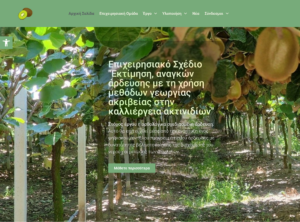Research Programs
The GIS Research Unit, relying on its personnel and utilizing its infrastructure:
- Implements competitive European and national research programs, research projects commissioned by public and semi-public sector organizations, research programs from private entities, studies, as well as educational programs that are either self-funded or commissioned by various bodies. The scientific coordinators of these programs are faculty members (DEP) and specialized teaching staff (EDIP) of the Agricultural University of Athens (AUA), who are part of the Gis Research unit team (Vasiliki Kollia-Kousouri, Dionysios Kalivas, Konstantinos Soulis, Stelios Gerontidis).
- Participates in and implements work packages or tasks within research projects, with scientific coordinators being faculty members of the AUA.
Overall, the Gis Research Unit has implemented or participated in 31 programs and is currently implementing 17 ongoing projects.
In Progress
 The Operational Plan (OP) M16SYN2-00012, is implemented within the framework of Measure 16 of the Rural Development Program (RDP) 2014-2020 of the Ministry of Rural Development and Food and is co-financed by the European Agricultural Fund for Rural Development " E.G.T.A.A."
The Operational Plan (OP) M16SYN2-00012, is implemented within the framework of Measure 16 of the Rural Development Program (RDP) 2014-2020 of the Ministry of Rural Development and Food and is co-financed by the European Agricultural Fund for Rural Development " E.G.T.A.A."
It is widely accepted that agriculture plays an irreplaceable role in economic development and food security. Among the sectors of economic activity (agriculture, industry, tourism), which compete for the limited available water resources, agriculture occupies a prominent position. Irrigated agriculture constitutes the largest consumer of water (70 to 80% of the annual water consumption in Greece). Consequently, the need for more sustainable water management is imperative.
With the use of new technologies such as ground sensors and the use of digital tools such as taking images from satellites and aerial vehicles, it is possible to adopt a smart irrigation system that will aim to save water and reduce the reckless use of water resources. The monitoring of meteorological data in combination with the climatic parameters prevailing in the area of the plots of interest can contribute to the assessment of the water status of the latter, the water stress and the prediction of the needs that may exist.
The specific digital system will also be able to be used in plant nutrition, as it will be able to issue a fertilization proposal for the plots of land that will be irrigated. Furthermore, it can offer in the field of plant protection with the aim of reducing the use but also the volume of preparations that are used to an excessive degree and burden natural resources.
 The Operational Plan (OP) M16SYN2-00011, is implemented within the framework of Measure 16 of the Rural Development Program (RDP) 2014-2020 of the Ministry of Rural Development and Food and is co-financed by the European Agricultural Fund for Rural Development. E.G.T.A.A."
The Operational Plan (OP) M16SYN2-00011, is implemented within the framework of Measure 16 of the Rural Development Program (RDP) 2014-2020 of the Ministry of Rural Development and Food and is co-financed by the European Agricultural Fund for Rural Development. E.G.T.A.A."
Peaches are popular fruits due to their high nutritional value and pleasant taste. However, they are among the perishable products, as their bark is sensitive to weather conditions and diseases. The time of picking the fruits is also an important problem in the cultivation of peaches, especially industrial peaches, as early picking degrades the quality of processing products (e.g. compost).
The harvesting of industrial peaches is done by the producers based on visual observation, with the result that they are often cut early. However, the result is negative both in the income of the producers and in the quality of the produced product. Due to their harvesting earlier than the time of ripening, the fruits mainly lag behind in organoleptic characteristics. Subsequently, unripe fruits that are forwarded to the processing units due to their low quality level are either rejected or cannot yield products of high quality value.
All of the above have a negative effect on the profit of agricultural holdings, i.e. on ensuring their sustainability. Finding a way to estimate the right time to harvest the fruits is deemed necessary. Modern digital technologies will make a significant contribution to this sector, significantly improving the quality of the produced product and at the same time the economic efficiency of agricultural holdings.
